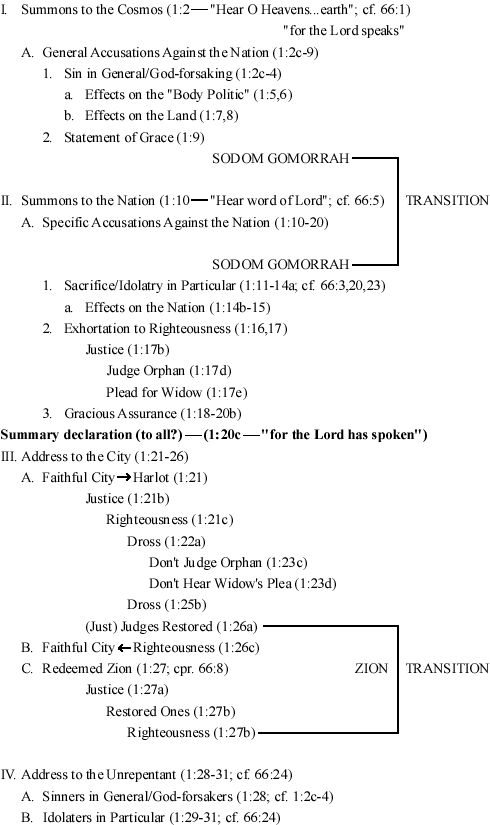
[K:NWTS 4/1 (May 1989) 36-40]
The opening chapter of Isaiah has been called the Prologue to the prophet's message. These initial verses are alleged to contain the themes of the entire book in summary fashion. According to one's critical assessment, this means chapter 1 is the Prologue to the first 39 chapters (on the hypothesis that these are, more or less, the authentic product of the historical Isaiah); or the chapter is the prelude to the corpus of 66 chapters (on the traditional hypothesis that the historical Isaiah is the author of the entire work). While the themes of the first chapter do reappear throughout the book, the denomination "Prologue" may be more than the evidence will bear. Still, it is interesting to note the similarities in vocabulary between chapter 1 and chapter 66 (? Prologue and Epilogue). At least 28 Hebrew terms are duplicated in the two chapters. This symmetrical repetition of vocabulary suggests an inclusio, i.e., the book begins and ends with the same images. While this phenomenon would suggest unity of authorship, critical/liberal resort to redaction (editorial reworking) preserves the division into (First) Isaiah (1-39) and Deutero (Second)-Isaiah (40-66). I am persuaded that the theory of a redactor/editor is unnecessary to account for the symmetry. The historical Isaiah was as artistically creative as any hypothetical post-exilic (i.e., after the return from the Babylonian captivity, ca. 539 B.C.) redactor. In other words, positing a redactor for similarities between chapters 1 and 66 is a post hoc propter hoc fallacy. If the book has already been divided at chapter 40 because of a critical presupposition (i.e., no pre-exilic prophet could paint the post-exilic hope so articulately and precisely), then similar vocabulary is obviously the result of a school of Isaianic editors. But if the historic Isaiah is capable of genuine eschatological projection, no such anti-supernatural bias is necessary to explain the imagery of chapters 40-66.
The eschatological sensitivities of Isaiah are evident in chapter 2 and 4�the projection of the eschatological Zion/Jerusalem. That this theme originates with the historic Isaiah is uncontested by even critical scholars who denominate these sections as part of Isaiah's "Zion Theology".
I would like to suggest a structural outline of chapter 1 consonant with this so-called "Zion Theology". The outline has the advantage of strengthening the unity of the early chapters of Isaiah.
STRUCTURE OF ISAIAH 1

The basic feature of chapter 1 is the contrast between two cities (or city complexes)�Sodom/Gomorrah and Zion. Ironically, the prophet subsumes his own Jerusalem under both images. In other words, much of Isaiah will detail the Jerusalem of his own day as a Sodom and Gomorrah. But he will project a new and better Jerusalem�a Zion which will endure as the obverse of all that he perceived. That pattern is displayed in the transitional bridges of the outline. You will note that each bridge unites the segments of the chapter through duplication. The repetition of Sodom and Gomorrah in verses 9 and 10 is an emphatic expansion of the general indictment of Judaean/Israelite society (1:2c-9) and the specific accusation of idolatry, social injustice and oppression (1:11-17). Like Sodom and Gomorrah, Jerusalem in the 8th century B.C. is generally rebellious, sinful and diseased. She is also a city filled with religious formalism, syncretistic idolatry, injustice and neglect (if not outright oppression) of the weak and helpless (orphan and widow).
Still the message of the prophet is not the hopeless doom of a decadent nation-city. The hints of grace (1:9, 18-20) are taken up and emphatically focused in a redeemed Zion. The bridge to the new Jerusalem is also significantly described in duplicate images. First is the pattern of reversal: the faithful city which has become a harlot (like Sodom and Gomorrah, 1:21) will be transformed to become a faithful city once more. Note the inclusio: qireyah ne'emanah (1:21); qireyah ne'emenah (1:26). Even more suggestive is duplication in Hebrew roots from verse 26 to verse 27.
In other words, the transitional movement from history to eschatology is bridged via duplication of structure. Jerusalem as Sodom and Gomorrah; Jerusalem as a city of justice, righteousness and repentance (restoration). The Jerusalem that now is is to be surpassed by the Jerusalem which will be.
The structure of the chapter serves to develop Isaiah's theological point. The Jerusalem he lives in is not the Jerusalem that endures. She is a city bent on self-destruction through her general and particular iniquities. The Jerusalem he envisions is a Jerusalem purged of the dross of this present evil metropolis. She is a city resplendent in righteousness, established in justice and peopled with the penitent whose scarlet sins have been washed whiter than snow. The eschatological Zion of Isaiah is the Jerusalem above of Paul, Hebrews and John. She is a city where the helpless dwell in safety because she is an eternal Uru salim ("City of Peace").
Preaching this first chapter of Isaiah may take a clue from the structure outlined above. Focus on the contrast between the two cities�the city which is about to pass away; the hope of a city which endures. Emphasize the realization that the people of God of these last times inhabit provisionally the city of Isaiah's vision. That vision has been outlined afresh in the fullness of the times by the one who is not only the eschatological prophet, but the eschatological servant-prophet�Ebed Yahweh! He is the one who opens the gate to the heavenly Zion�the everlasting city of the Great King.
In a future issue, I hope to offer an example of a sermon based on Isaiah's "Tale of Two Cities."